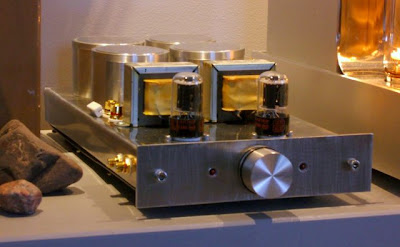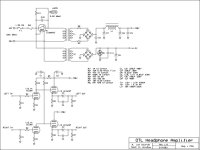This is my first tube amp built three years ago. It is dual mono, based on Fred Nachbaur´s MiniBlok SET with 13EM7 tubes.

It was just lifted out of the workshop. The dummyloads are still in and the bottom is not yet properly mounted. I made transformer covers out of aluminum pipe with CNC cut covers. Press fit. I botched the job on the output transformers, and ended up not covering them up (still haven´t)
It was just lifted out of the workshop. The dummyloads are still in and the bottom is not yet properly mounted. I made transformer covers out of aluminum pipe with CNC cut covers. Press fit. I botched the job on the output transformers, and ended up not covering them up (still haven´t)
An externally hosted image should be here but it was not working when we last tested it.
Very original!
Atomium design?
Atomium design?
An externally hosted image should be here but it was not working when we last tested it.
IMHO, nice design is one that is functional. Any spoiler spoils the design literally.
However, YMMV...
Aah the classic question: Does form follow function or does form follow fun?
Form follows function is a lot easier to get "Right" and right is often the most harmonious and pleasing solution. Fun? It´s difficult to make something with a depth of meaning and interpretation when design is fun. Not sure I did in this case
Form follows function is a lot easier to get "Right" and right is often the most harmonious and pleasing solution. Fun? It´s difficult to make something with a depth of meaning and interpretation when design is fun. Not sure I did in this case
An externally hosted image should be here but it was not working when we last tested it.
I must see this when finished.And this is my work-in-progress based on the GU32 tube. It is a push pull amp. The outlandish styling has posed some problems, so it is slow going.

Aah the classic question: Does form follow function or does form follow fun?
IMHO, priorities are:
1. Function
2. Materials used
3. Fun
It's the first copy of that design I see here, after thousands of wooden boxes with tubes on top.. So which is more original?
Have to agree. I think the wood is a nice relief though from plain Hamond chassis. Nothing more boring. A mix somethimes works well too.It's refreshing to see metal enclosure for tube gears after barrage of woody chassis.
Still waiting to see someone come up with wooden input and speaker terminals.
That spaceship was designed to travel at speed of light, your amp is going to be still most of the time, no fancy aerodynamics needed. Oh and in case you move it around the room I predict turtle pace, that thing looks heavy; only advantage is that you can hold it by the horns or antennas or bulging eyes or whatever that is.
Yeah, pretty tired of those myself.
after thousands of wooden boxes
Yeah, pretty tired of those myself.
My daughter named it the moose!
I am quite happy that the amp provokes different opinions.
The function of form is to communicate meaning, create experiences and ideas. Good design obviously functions, that is its reason for being. Beyond function products should be good to use, pleasing and interesting. All these factors are contextual, and in the eyes of the beholder.
I have seen hundreds of wood chassis amplifiers, Some are exquisitely well detailed and proportioned. I plan to make one for myself (6C33C) to go with my Empire Scientific turntable, and can only hope to come close.
I am quite happy with the expression of weight, that "stalker" mentions. I have been exploring ways to give the spheres more volume to match the body better. I will have separate B+, signal and heater cables that I hope will achieve better balance of the totality. It is stunt design so nothing is planned yet.
I am quite happy that the amp provokes different opinions.
The function of form is to communicate meaning, create experiences and ideas. Good design obviously functions, that is its reason for being. Beyond function products should be good to use, pleasing and interesting. All these factors are contextual, and in the eyes of the beholder.
I have seen hundreds of wood chassis amplifiers, Some are exquisitely well detailed and proportioned. I plan to make one for myself (6C33C) to go with my Empire Scientific turntable, and can only hope to come close.
I am quite happy with the expression of weight, that "stalker" mentions. I have been exploring ways to give the spheres more volume to match the body better. I will have separate B+, signal and heater cables that I hope will achieve better balance of the totality. It is stunt design so nothing is planned yet.
Last edited:
I'd like to show off my very first scratch-built audio component.
This is my take on the Van Waarde 6DJ8+6AS7 OTL headphone amplifier project. It uses my own non-regulated solid-state supply with a thermal relay to delay full B+ for a minute or so. A small lamp seen in front of the relay turns off when the amp is fully preheated -- sort of like the lamp on an oven.
Performance wise, I surprised myself with this. Despite having everything on one chassis, the background is silent, and the amp sounds beautiful. In fact, now I can hear every flaw in the rest of my equipment! I made an effort to bring all grounds to one point, so I'm sure that helped it quite a bit.
Overall, I'm very proud of my first amplifier.
To those curious, the big chunk of equipment behind it is my 120V:0-240V variac that I found in quite poor shape at a junk store, and lovingly restored.
I got lucky and found the 6AS7G and four "Bugle Boy" 6DJ8/ECC88 for $5 each at another local shop.
This is my take on the Van Waarde 6DJ8+6AS7 OTL headphone amplifier project. It uses my own non-regulated solid-state supply with a thermal relay to delay full B+ for a minute or so. A small lamp seen in front of the relay turns off when the amp is fully preheated -- sort of like the lamp on an oven.
Performance wise, I surprised myself with this. Despite having everything on one chassis, the background is silent, and the amp sounds beautiful. In fact, now I can hear every flaw in the rest of my equipment! I made an effort to bring all grounds to one point, so I'm sure that helped it quite a bit.
Overall, I'm very proud of my first amplifier.
An externally hosted image should be here but it was not working when we last tested it.
To those curious, the big chunk of equipment behind it is my 120V:0-240V variac that I found in quite poor shape at a junk store, and lovingly restored.
I got lucky and found the 6AS7G and four "Bugle Boy" 6DJ8/ECC88 for $5 each at another local shop.
Last edited:
I'd like to show off my very first scratch-built audio component.
This is my take on the Van Waarde 6DJ8+6AS7 OTL headphone amplifier project. It uses my own non-regulated solid-state supply with a thermal relay to delay full B+ for a minute or so. A small lamp seen in front of the relay turns off when the amp is fully preheated -- sort of like the lamp on an oven.
Performance wise, I surprised myself with this. Despite having everything on one chassis, the background is silent, and the amp sounds beautiful. In fact, now I can hear every flaw in the rest of my equipment! I made an effort to bring all grounds to one point, so I'm sure that helped it quite a bit.
Overall, I'm very proud of my first amplifier.
An externally hosted image should be here but it was not working when we last tested it.
To those curious, the big chunk of equipment behind it is my 120V:0-240V variac that I found in quite poor shape at a junk store, and lovingly restored.
I got lucky and found the 6AS7G and four "Bugle Boy" 6DJ8/ECC88 for $5 each at another local shop.
Share the schematic?
Sure, here it is as I've built it. I am by no means an expert on this stuff yet, so if anything looks silly that would be why. 
The amplifier itself is pretty much unchanged, other than some slight value substitutions based on what was available. The B+ supply is also similar, other than using a bridge rectifier I had on hand and a delay on the primary side.
I chose not to regulate the heater supply (and I don't even have the big filter cap on it right now, either) but it sounds fine to me; at least better than anything I've heard so far.
Of course a bit of B+ appears at the start due to current through the preheat lamp, but not all the way until the relay closes.
The amplifier itself is pretty much unchanged, other than some slight value substitutions based on what was available. The B+ supply is also similar, other than using a bridge rectifier I had on hand and a delay on the primary side.
I chose not to regulate the heater supply (and I don't even have the big filter cap on it right now, either) but it sounds fine to me; at least better than anything I've heard so far.
Of course a bit of B+ appears at the start due to current through the preheat lamp, but not all the way until the relay closes.
Attachments
Last edited:
Two things I note here is: 6AS7(s) have extremely low plate impedance to start with and it is a cathode follower. Both of these factors mean low output impedance. I like.Sure, here it is as I've built it. I am by no means an expert on this stuff yet, so if anything looks silly that would be why.
The amplifier itself is pretty much unchanged, other than some slight value substitutions based on what was available. The B+ supply is also similar, other than using a bridge rectifier I had on hand and a delay on the primary side.
I chose not to regulate the heater supply (and I don't even have the big filter cap on it right now, either) but it sounds fine to me; at least better than anything I've heard so far.
Of course a bit of B+ appears at the start due to current through the preheat lamp, but not all the way until the relay closes.
Have you varied the orginal schematic?
Sure, here it is as I've built it. I am by no means an expert on this stuff yet, so if anything looks silly that would be why.
The amplifier itself is pretty much unchanged, other than some slight value substitutions based on what was available. The B+ supply is also similar, other than using a bridge rectifier I had on hand and a delay on the primary side.
I chose not to regulate the heater supply (and I don't even have the big filter cap on it right now, either) but it sounds fine to me; at least better than anything I've heard so far.
Of course a bit of B+ appears at the start due to current through the preheat lamp, but not all the way until the relay closes.
looks nice!
all DC coupled too!
might give it a try myself!
finished a 6EM7 headphone amp and had quite a bit of trouble keeping it quiet.
in the end it was the fillement of the rectifier tube vibrating with 50Hz.
do you need the fan?
- Home
- Amplifiers
- Tubes / Valves
- Photo Gallery

